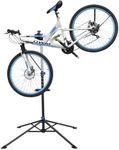Buying Guide for the Best Bicycle Repair Stands
Choosing the right bicycle repair stand is crucial for anyone who wants to perform maintenance on their bike efficiently and comfortably. A good repair stand will hold your bike securely, allowing you to work on it at a comfortable height and angle. When selecting a repair stand, consider the type of bike you have, the space you have available, and how often you plan to use the stand. Here are some key specifications to consider when choosing a bicycle repair stand.Weight CapacityWeight capacity refers to the maximum weight the stand can support. This is important because you need a stand that can safely hold your bike without tipping over or collapsing. Lightweight road bikes may only require a stand with a lower weight capacity, while heavier mountain bikes or e-bikes will need a stand that can support more weight. Make sure to check the weight of your bike and choose a stand that can handle at least that much weight, ideally with some extra capacity for added stability.
Clamp MechanismThe clamp mechanism is what holds your bike in place on the stand. This is important because a secure clamp will keep your bike steady while you work on it. Clamps can vary in design, with some being quick-release for easy use and others being more adjustable for a precise fit. If you have a bike with a delicate frame, look for a clamp with rubberized jaws to prevent damage. Consider how easy the clamp is to use and how securely it holds your bike when making your choice.
Height AdjustabilityHeight adjustability allows you to raise or lower the bike to a comfortable working height. This is important for reducing strain on your back and making it easier to access different parts of the bike. Stands with a wide range of height adjustments are more versatile and can accommodate different users and bike types. If you plan to do a lot of work on your bike, look for a stand that offers easy and precise height adjustments.
StabilityStability refers to how well the stand stays in place while you work on your bike. This is important because a stable stand will prevent your bike from wobbling or tipping over, making it safer and easier to work on. Look for stands with wide, sturdy bases and non-slip feet. If you have a heavier bike or plan to do more intensive repairs, a stand with a tripod or quad-leg design will offer better stability.
PortabilityPortability refers to how easy it is to move and store the stand. This is important if you have limited space or need to transport the stand to different locations. Lightweight stands that fold up compactly are ideal for those who need to store the stand in a small space or take it with them to races or rides. However, more portable stands may sacrifice some stability, so consider how often you need to move the stand versus how stable you need it to be.
MaterialThe material of the stand affects its durability and weight. This is important because a durable stand will last longer and provide better support for your bike. Common materials include steel and aluminum, with steel being heavier and more durable, and aluminum being lighter and more portable. If you need a stand that is easy to move around, aluminum may be a better choice, but if you need maximum durability and stability, steel is the way to go.















